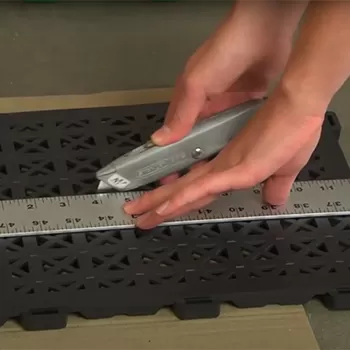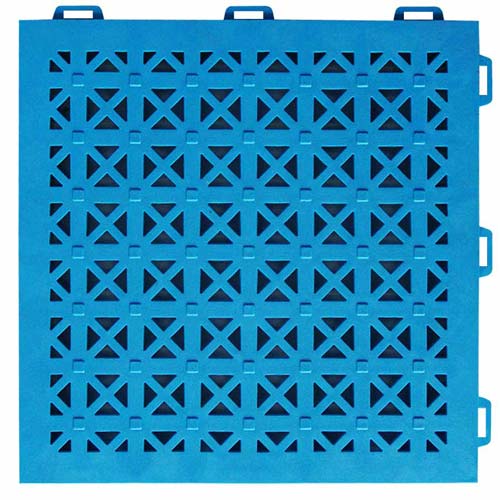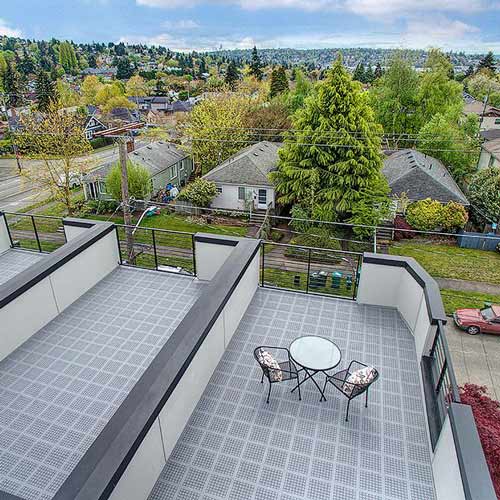How To Install StayLock Perforated Deck and Playground Tiles
Related Product: StayLock Tile Perforated Colors 9/16 Inch x 1x1 Ft.
These modular PVC tiles are suitable for a variety of installations. If you’re placing an outdoor flooring over dirt, these raised tiles can help to keep kids up and out of the mud. They’re also suitable for a temporary outdoor flooring over mowed grass installation. Left in place for too long and the tiles could inhibit the grass’ growth, but they’re ideal for temporary use for an instant patio or other surface.
How to Install StayLock Perforated Tiles
These tiles offer a quick and easy installation, which makes them a highly popular option. You can lay them over any hard, flat surface, including concrete, wood, carpet, tile, and a pool surround. You can also lay them over an existing deck or patio to revitalize the surface and make it safer and more enjoyable for your family and visitors.To start your installation, begin in a corner with the tile’s loop side facing out. You’ll want to keep one straight side against the wall or perimeter of the area, and then the other over the loops. Press the nubs of each new tile down onto the loops of the existing tile until they snap into place.
As you work, lay your tiles in a triangular fashion, and make sure that you always keep the loops facing out. Once you’ve reached the opposite wall or perimeter and you can’t fit any more full tiles you're ready to cut the remaining tiles to fit. Measure the distance between the tiles and the wall or edge.
Use a straight edge to guide your cut, and make repeated shallow scores with a sharp utility knife. Snap the final tiles in and you’re done.
If you’re installing these tiles up against a wall or other firm surface, we recommend you leave a ½-inch gap between the tiles and the wall. This gap allows the tiles to expand and contract with changing temperatures, helping to prevent them from buckling as they expand.
Ramped border edges are available for both nub and loop tile edges, and these pieces can create a safer entrance onto and exit off of these tiles, helping to keep people from tripping. These pieces are for sale separately.
How to Install Deck Tiles on Uneven Surface
 You don’t need a perfectly even surface to install StayLock tiles. If you’re working with a slightly uneven surface, the tiles are flexible enough to conform to match its contours.
You don’t need a perfectly even surface to install StayLock tiles. If you’re working with a slightly uneven surface, the tiles are flexible enough to conform to match its contours.
There can be a slight difference in grading, and you can still create an instant patio or other structure with the tiles.
If the area is significantly uneven, then you’ll want to grade it to make it as flat and as firm as possible for the best results.
How to Install the Tiles on Rooftops
 Due to their convenient DIY design, superior drainage capabilities and soft material, Staylock Tiles are becoming increasingly popular for small roof top patios.
Due to their convenient DIY design, superior drainage capabilities and soft material, Staylock Tiles are becoming increasingly popular for small roof top patios.
These tiles have rounded edges on their underside, which helps to reduce the chance of them puncturing a rubber roofing membrane.
This design still allows the tiles to drain effectively.
How to Relocate StayLock Tiles
StayLock tiles create a secure connection, so you don’t need to worry about using adhesives. This also makes the tiles portable and removable. If you need to, you can disconnect the tiles in the future and relocate them or reinstall them.How do I keep grass or weeds from growing through my patio tiles?
 While perforated patio tiles offer excellent water drainage, if they’re installed over dirt or grass, it’s possible for weeds and grass to grow up through those perforations.
While perforated patio tiles offer excellent water drainage, if they’re installed over dirt or grass, it’s possible for weeds and grass to grow up through those perforations.
To prevent this, we recommend laying landscaping fabric or weed-blocker fabric underneath the tiles at the time of installation.
Even if your lawn, yard or other space isn't weedy to start with, it will help keep grass and other plants from poking up through your new patio flooring.
What is the cheapest way to do a patio?
 One of the cheapest and simplest ways to create a patio is to install PVC or rubber pavers on grass.
One of the cheapest and simplest ways to create a patio is to install PVC or rubber pavers on grass.
Using flexible outdoor interlocking tiles can give you an instant patio on grass or dirt.
There’s no need to worry about creating a foundation, and if you choose durable tiles, you can use your outdoor patio for years.
Can interlocking deck tiles be cut?
 Many interlocking deck tiles, including the StayLock Perforated Deck and Playground Tiles, can be easily cut, which is ideal when you’re working within a designated space or need to install the tiles around corners or other objects. You can cut many tiles with a sharp utility knife, using a straight edge to guide your cuts. Repeated, shallow scores will often get you the best, cleanest results.
Many interlocking deck tiles, including the StayLock Perforated Deck and Playground Tiles, can be easily cut, which is ideal when you’re working within a designated space or need to install the tiles around corners or other objects. You can cut many tiles with a sharp utility knife, using a straight edge to guide your cuts. Repeated, shallow scores will often get you the best, cleanest results.














